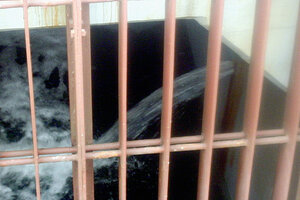Why is Japan dumping radioactive water into the ocean?
Japanese officials allowed owners of the damaged Fukushima nuclear power plant to empty tanks holding 10,000 tons of slightly radioactive water into the ocean – in order to make room to pump highly contaminated water out of reactor No. 2.

Radioactive water leaks into the sea near the No. 2 reactor of Fukushima Daiichi nuclear nuclear power plant in northeastern Japan, April 2. Workers labored through the weekend to find the source of the leak. Unable to do so, they dumped slightly radioactive water into the ocean in order to free up tank space to pump out highly radioactive water from the suspect area.
Tokyo Electric Power Co. / Kyodo News / AP
Radioactive water continued to drain from the damaged Fukushima Daiichi nuclear plant into the Pacific Ocean on Monday, as Japanese officials mounted a desperate effort to find and plug the source of the leak.
On Saturday, the Tokyo Electric Power Company (TEPCO) thought it had discovered the leak’s headwaters – a crack in a concrete pit near reactor No. 2. TEPCO workers poured concrete into the pit to close the breach, but the leak continued.
On Sunday, workers broke through the top of a connecting trench and dumped in a mix of sawdust, newsprint, and absorbent polymers in an attempt to glue the leak shut. That didn’t work either, noted the International Atomic Energy Agency in a Monday update on Fukushima’s status: “Leaking has not stopped.”
Radioactive water
As the Fukushima crisis passes the three-week mark, the thousands of tons of water – used to keep crippled reactors and spent-fuel pools cool – are becoming an increasing concern.
Much of the water evaporates, or else collects inside spent-fuel pools or other secure areas. But in the wake of the March 11 earthquake, water has also escaped from the damaged reactor buildings, flowing into the maintenance tunnels and basements, and then to unknown parts.
The problem now is that TEPCO does not have enough storage tank capacity at the site in which to store contaminated water. That is why the Japanese government Monday authorized Fukushima workers to release 10,000 tons of wastewater containing low-level radioactivity directly into the sea.
Dumping this water should free up space for TEPCO to pump highly contaminated water out of reactor No. 2’s basement and tunnels, potentially putting an end to the leakage problem.
“The fact that they’re encountering ... these large sources of contaminated water – and still are unable to say exactly where it’s coming from – is troubling,” said Edward Lyman, a senior scientist in the Global Security Program at the Union of Concerned Scientists, in a briefing for reporters late last week.
Treating radioactive water – if contained – is easy enough, noted Dr. Lyman. Reprocessing plants could boil off pure water, concentrating the radioactivity into a denser waste solution. Filters can also remove some contaminants.
“Over time ... assuming the situation is stabilized and they were able to get at least the physical capacity to store the liquids, then they would just be left with potentially a high-level radioactive waste problem, like the US has in spades with liquid waste left over from defense production,” said Lyman.
Tracing the leak
While pumping water out of the damaged reactor could help solve solve the problem, workers continue to try to identify the source of the leak. They have tried dumping a milky dye into the suspect pool to see if they can trace the water’s path. So far, that has not shown up in nearby ocean waters.
TEPCO now is weighing other strategies as it considers that the leak might be elsewhere.
One possible move: setting up undersea silt barriers near the reactor's seawater intake duct, in an attempt to block radioactive water from moving further into the ocean.
Response of the Japanese government
The Japanese government said it is becoming increasingly concerned about the amount of radioactivity that has already leached into surrounding waters.
Japan’s Nuclear and Industrial Safety Agency says the disposal of the low-level waste is an emergency measure and that it will increase monitoring of water and sea life in the surrounding area to ensure levels of radioactive iodine do not spike too high.
“Even if they say the contamination will be diluted in the ocean, the longer this continues, the more radioactive particles will be released and the greater the impact on the ocean,” said Chief Cabinet Secretary Yukio Edano at a press conference. “We are strongly urging TEPCO that they have to take immediate action to deal with this.”
